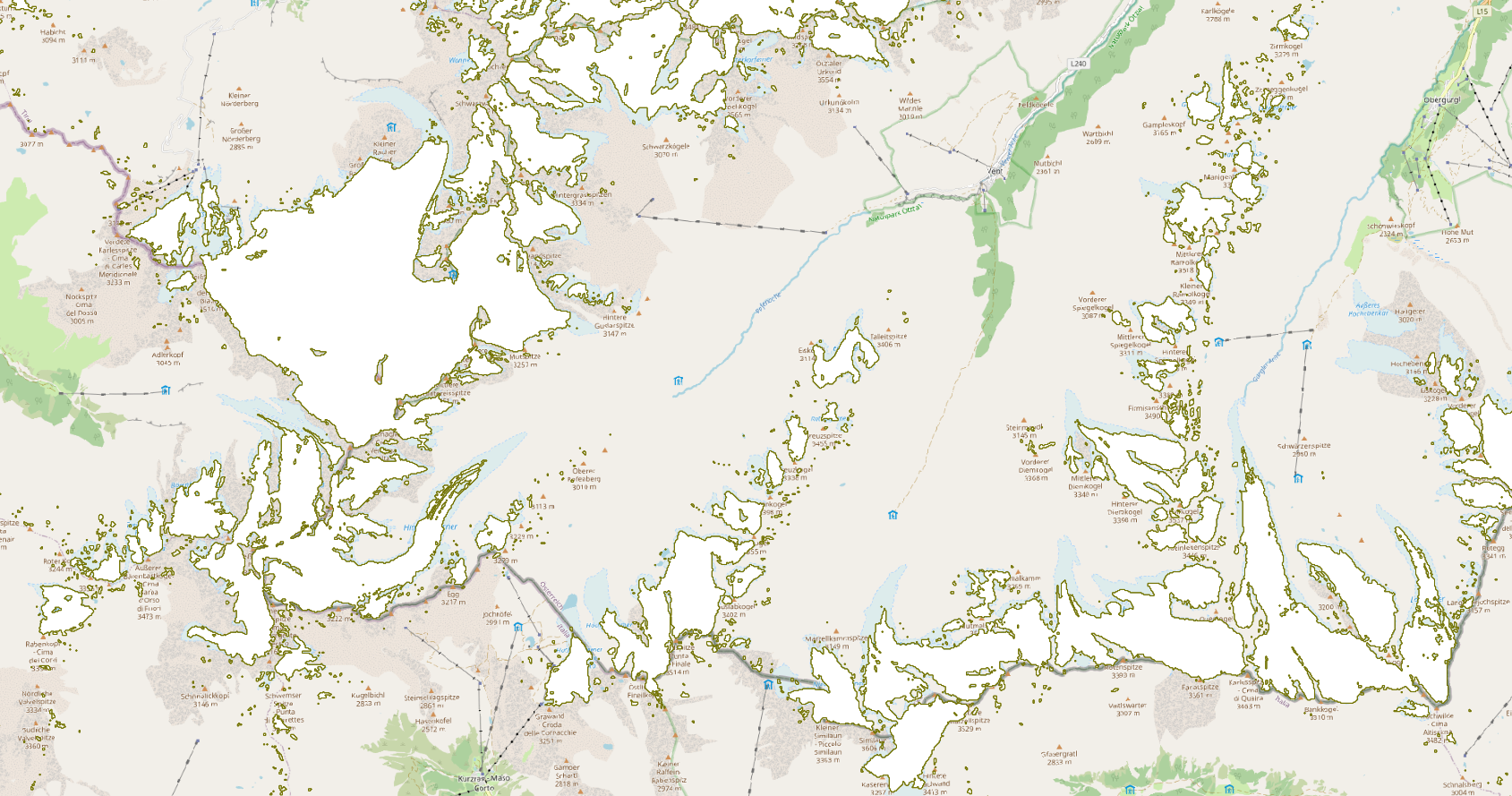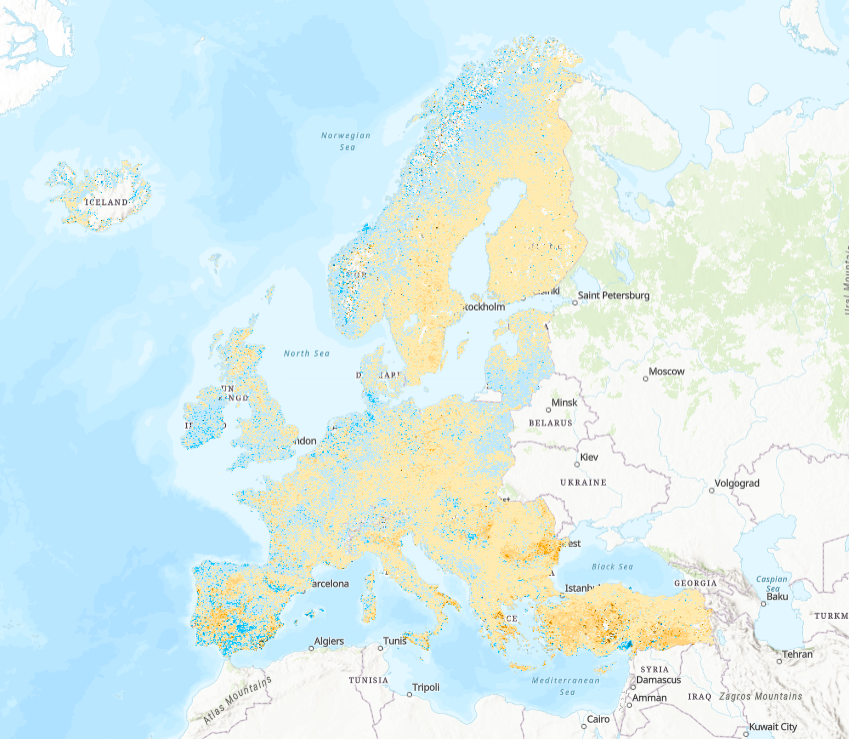Annually
Type of resources
Available actions
Topics
INSPIRE themes
Keywords
Contact for the resource
Provided by
Years
Formats
Representation types
Update frequencies
Resolution
-

This data set raster file is the above ground vegetation season length time-series for the period 2000-2016. The data set addresses trends in the season length of land surface vegetation derived from remote sensing observed time series of vegetation indices. The vegetation index used in the indicator is the Plant Phenology Index (PPI, Jin and Eklundh, 2014). PPI is based on the MODIS Nadir BRDF-Adjusted Reflectance product (MODIS MCD43 NBAR). The product provides reflectance data for the MODIS “land” bands (1 - 7) adjusted using a bi-directional reflectance distribution function. This function models values as if they were collected from a nadir-view to remove so called cross-track illumination effects. The Plant Phenology Index (PPI) is a new vegetation index optimized for efficient monitoring of vegetation phenology. It is derived from radiative transfer solution using reflectance in visible-red (RED) and near-infrared (NIR) spectral domains. PPI is defined to have a linear relationship to the canopy green leaf area index (LAI) and its temporal pattern is strongly similar to the temporal pattern of gross primary productivity (GPP) estimated by flux towers at ground reference stations. PPI is less affected by presence of snow compared to commonly used vegetation indices such as Normalized Difference Vegetation Index (NDVI) or Enhanced Vegetation Index (EVI). The product is distributed with 500 m pixel size (MODIS Sinusoidal Grid) with 8-days compositing period.
-
Soil moisture deficit during the vegetation growing season, annual time-series, 2000-2019, Sep. 2020

The dataset consists of a collection of annual soil moisture (SM) anomalies during the vegetation growing season (GS) for the years 2000-2019 across EEA 38 area and the United Kingdom. The vegetation growing season is defined by EEA´s phenology data series "Vegetation growing season length 2000-2016", available in the EEA website and in this catalogue. The anomalies are calculated based on the European Commission's Joint Research Centre European Drought Observatory (EDO) Soil Moisture Index (SMI) with respect to the 1995–2019 base period. The yearly start and end of GS periods are dynamic and calculated according to the EEA Phenology Indicators. A positive anomaly indicates that the observed SM was wetter than the long-term SM average for the base period, while a negative anomaly indicates that the observed SM was drier than the reference value. Because SM anomalies are measured in units of standard deviation from the long-term SMI average, they can be used to compare annual deficits/surplus of SM between geographic regions. EDO is one of the early warning and monitoring systems of the Copernicus Emergency Management Service. As the dataset builds on EDO's SMI, it therefore contains modified Copernicus Emergency Management Service information (2019).
-

The Copernicus Persistent Snow Area (PSA) product is directly derived from the Fractional Snow Cover (FSC) information. It is generated on a yearly basis for the entire EEA38 and the UK and provides the extent of the persistent snow cover, i.e. the area where snow is present throughout the hydrological year with a spatial resolution of 20 m x 20 m. PSA is one of the products of the pan-European High-Resolution Snow & Ice service (HR-S&I), which are provided at high spatial resolution (20 m x 20 m), and are derived from the Sentinel-2 constellation data. They are generated over the entire EEA38 (32 member countries and 6 cooperating countries) and the United Kingdom, from September 1, 2016 onwards. Four types of HR-S&I products are proposed to users: the Fractional Snow Cover (FSC) product, the Persistent Snow Area (PSA) product, the River and Lake Ice Extent (RLIE) product and the Aggregated River and Lake Ice Extent (ARLIE) product. PSA is delivered in two different projections: (1) as tiles aligned with Sentinel-2 (UTM/WGS84) at 20 m x 20 m GSD; and (2) as tiles aligned with the Pan-European High-Resolution Layers in the European 20 m x 20 m grid (ETRS89 LAEA - EPSG: 3035). It is typically released on an annual basis with a release date in October, after the end of the hydrological year. Each PSA product is composed of two separate files corresponding to the two layers of the product, and another file containing metadata.
-

The dataset described here presents the geometries of the zones and agglomerations reported since 2013 by Member States in compliance with the Ambient Air Quality Directives and successfully validated by the EEA's Quality Control system. In accordance with the procedure referred to in Article 5 of 2011/850/EU on the reciprocal exchange of information and reporting on ambient air quality, Member States shall make available the information set out in Part B of Annex II to this Decision on the delimitation and type of zones and agglomerations established in accordance with Article 3 of Directive 2004/107/EC and Article 4 of Directive 2008/50/EC and in which the assessment and management of air quality is carried out. .... These data flows are described on Reportnet's ROD (Reporting Obligation Database): https://rod.eionet.europa.eu/obligations/670 and https://rod.eionet.europa.eu/obligations/693. More meta-information on zones, including data providers can be found at http://aideb.apps.eea.europa.eu
-

This raster data set corresponds to the above ground vegetation biomass productivity time-series for the period 2000-2016. The data set addresses trends in land surface productivity derived from remote sensing observed time series of vegetation indices. The vegetation index used in the indicator is the Plant Phenology Index (PPI, Jin and Eklundh, 2014). PPI is based on the MODIS Nadir BRDF-Adjusted Reflectance product (MODIS MCD43 NBAR. The product provides reflectance data for the MODIS “land” bands (1 - 7) adjusted using a bi-directional reflectance distribution function. This function models values as if they were collected from a nadir-view to remove so called cross-track illumination effects. The Plant Phenology Index (PPI) is a new vegetation index optimized for efficient monitoring of vegetation phenology. It is derived from radiative transfer solution using reflectance in visible-red (RED) and near-infrared (NIR) spectral domains. PPI is defined to have a linear relationship to the canopy green leaf area index (LAI) and its temporal pattern is strongly similar to the temporal pattern of gross primary productivity (GPP) estimated by flux towers at ground reference stations. PPI is less affected by presence of snow compared to commonly used vegetation indices such as Normalized Difference Vegetation Index (NDVI) or Enhanced Vegetation Index (EVI). The product is distributed with 500 m pixel size (MODIS Sinusoidal Grid) with 8-days compositing period.
-

The raster file is the time series of the start of the vegetation growing season. The start of the growing season time-series is based on the time series of the Plant Phenology Index (PPI) derived from the MODIS BRDF-Adjusted Reflectance product (MODIS MCD43 NBAR). The PPI index is optimized for efficient monitoring of vegetation phenology and is derived from the source MODIS data using radiative transfer solutions applied to the reflectance in visible-red and near infrared spectral domains. The start of season indicator is based on calculating the start of the vegetation growing season from the annual PPI temporal curve using the TIMESAT software for each year between and including 2000 and 2016.
-

The raster file is the temporal trend in the start of the vegetation growing season. The start of growing season dataset is based on the time series of the Plant Phenology Index (PPI) derived from the MODIS BRDF-Adjusted Reflectance product (MODIS MCD43 NBAR). The PPI index is optimized for efficient monitoring of vegetation phenology and is derived from the source MODIS data using radiative transfer solutions applied to the reflectance in visible-red and near infrared spectral domains. The start of season dataset is based on calculating the start of the growing season from the annual PPI temporal curve using the TIMESAT software. Change in the start of growing season was then calculated after fitting a linear trend and extracting the slope of the trend. Negative values refer to earlier start of the vegetation growing season, whereas positive values refer to later start of the vegetation growing season.
-

The data set provides the EEA 1 km and 2 km grids combining the monitoring air quality data in a ‘regression-interpolation-merging mapping’ methodology and the observational values of the air quality monitoring stations used in the interpolation. It covers Europe for the year 2018. It provides estimates for human health related indicators of pollutants PM10 (annual average, 90.4 percentile of daily means), PM2.5 (annual average), ozone (93.2 percentile of maximum daily 8-hour means, SOMO35, SOMO10) and NO2 (annual average), and vegetation related ozone indicators (AOT40 for vegetation and for forests) for the year 2018. The data set contains also Phytotoxic ozone dose (POD) for wheat and potato and NOx annual average grids for 2018. The POD data set is presented for the first time. This data set is used to estimate population and vegetation exposure to air pollution, as an input to the indicator CSI005 (Exposure of Europe's ecosystems to ozone) and for the health impact assessments published in the Air Quality in Europe reports. The methodology and the corresponding maps can be found in the 2020 Eionet report "European air quality maps for 2018. PM10, PM2.5, Ozone, NO2 and NOx Spatial estimates and their uncertainties" (ETC/ATNI Report 10/20) available at https://www.eionet.europa.eu/etcs/etc-atni/products/etc-atni-reports/etc-atni-report-10-2020-european-air-quality-maps-for-2018-pm10-pm2-5-ozone-no2-and-nox-spatial-estimates-and-their-uncertainties-1. This data set includes the station values and the gridded interpolated values in Shapefile format and the interpolated values in OVR and GeoTIFF formats. It can also be downloaded in Spatialite-Rasterlite. For convenience, the data set also includes the maps in TIFF and PNG format included in the report.
 RUC Geo-Data catalogue
RUC Geo-Data catalogue